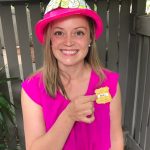This post was written by member Jessie Dorin.
When I was eight, my bipolar dad put me on our unbroken horse with the advice, “Roll away from the hooves when he bucks you off.” Even better advice? Don’t let a bipolar ex–bull rider talk you into breaking the new family horse. But I was eight, and I loved my dad. So I got bucked off. A lot. Finally, after too many weekends, my dad gave up. But I never forgot how that horse looked at me. It was a look that clearly said, “Please don’t break me.” I’m pretty sure my own face revealed the same plea.
Over the years, I’ve seen how mitigating the long-term effects of Adverse Childhood Experiences (ACEs) begins with teacher vulnerability and looking for trauma clues. But there are some students who will never talk about their ACEs because to do so would be too painful. Their eyes will tell you, “Please don’t break me.” So I refer those students to the counselor even though they won’t go, and then I turn to the other gateway to connection: what we love.
Horse whisperers don’t call what they do “breaking” a horse. They call their method “making” a horse. Teachers can help “make” students by connecting to what students love and, especially, how they love it. For example, I have a good friend who is a filmmaker/scientist. I’ve never grasped scientific concepts easily, but when my friend explains the mating rituals of hummingbirds or why we don’t ride zebras, I fall in love with the natural world. She brings her whole self—personality, insights, and a particular way of explaining things—to the non-science-minded. We connect in science through her eyes.
Recently, I had a student so dark, he was my Black Hole Kid. He seethed in his seat, refused to participate, sucked other kids into his foul mood, and drew furiously in his notebook. So I sat him next to the peppy cheerleaders and praised the heck out of his drawing. I found ways to include his artwork in assignments. I dragged him in front of the class to present, and it turns out he was a closet comedian. Gradually, he became a part of our classroom community, loved for being himself. None of this took much effort from me, but it was the difference between the absence of a student in the room, a black hole, and a vibrant kid sharing and shining his light.
This matters for his life and it matters for mine. A kid hurt beyond his own recognition of self will hurt himself and hurt others. Someone who is able to see the value of all parts of himself has the motivation to heal himself, and in doing so, he will grow to be someone with enormous capacity to help heal others. His particular experience of hurt, the ways in which he eventually heals that hurt, coupled with his grumpy, slyly humorous personality and love of drawing, will someday all come together to be his particular brand of healing—his original medicine. We all have original medicine, and we all need others, at one time or another, to use their medicine to help us heal ourselves. My science friend helps heal the part of me that can feel disconnected from the natural world. She makes me sit in wonder again.
Caroline McHugh, in her brilliant TED talk, The Art of Being Yourself, gives a lovely example of what it is to step into yourself. Instead of comparing ourselves to others by feeling inferior or superior, she suggests going inward, which leaves comparison out of the picture entirely. There is only you. Feel the freedom in that. We are what we love and how we love it. We are also how we heal and how we share ourselves with others. What would it be to share yourself in a way that profoundly helped other people just by doing and being what makes you so uniquely you?
The story of bringing my black-hole student into the classroom community, in making him rather than breaking him, is an example of how teachers can help students who are not going to give up information about past or present ACEs. That’s okay. We aren’t here to “break” anyone. Teachers are here to drop a life line for students who want to share. For students who don’t, we can help “make” them, listening for what they love and finding ways to nurture that. We give students opportunities to share themselves with others and plant the idea that they are people who matter to the world around them. When those students are ready to heal, they already know there is someone inside of them worth leading out of the darkness.
 Jessie Dorin has been teacher for 15 years,12 of those years in San Francisco’s continuation high schools. Currently, she teaches workshops on uncovering hidden student ACEs. You can find her at JessieDorin.com.
Jessie Dorin has been teacher for 15 years,12 of those years in San Francisco’s continuation high schools. Currently, she teaches workshops on uncovering hidden student ACEs. You can find her at JessieDorin.com.

